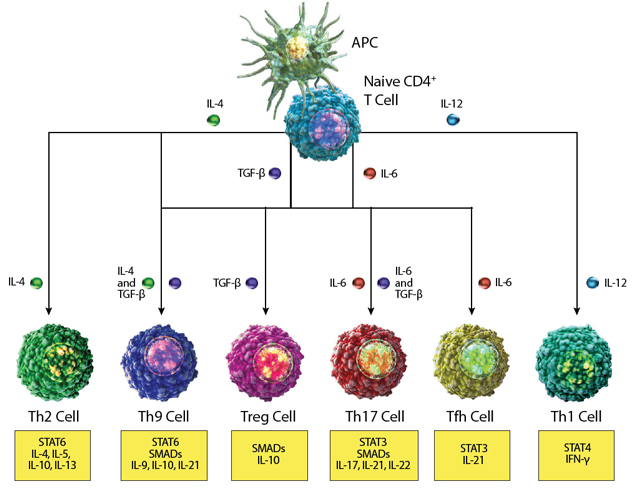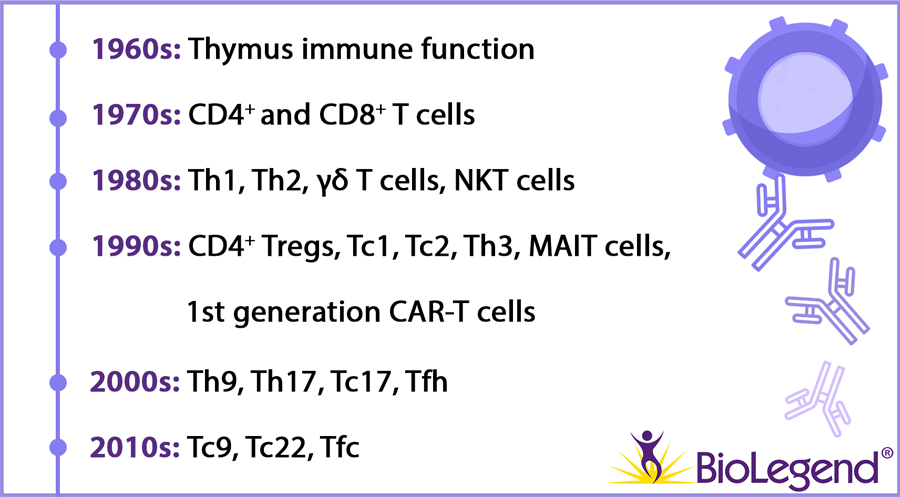T Cells: A 60-Year Tale
This blog originally appeared on Nature’s Milestones website. Modifications may have been made since the blog's debut. Explore their site for additional articles and insights on T cell research.
BioLegend has supported T cell researchers for more than 20 years, but our deep understanding of T cells began decades earlier. T cells are an integral member of adaptive immunity and support the function of several other immune cells. Here, we review historic T cell milestones.
To continue advancing T cell research, we consistently create new tools for scientists. Explore our Human CD3/CD28 Stimulation Beads for your in vitro T cell application needs.

(Left) Isolated human CD3+ T cells were expanded with Human CD3/CD28 T Cell Activation Beads. At day 3 post-activation, the beads were removed using a MojoSort™ Magnet while the cells remained in culture in the presence of IL-2. (Right) PD-1 expression at day 5 of culture of human CD3+ T cells stimulated with Human CD3/CD28 T Cell Activation Beads. At day of harvest, cells were stained with anti-human CD3 APC and anti-human PD-1 BV421™ and were analyzed by flow cytometry.
Thymic Function
While we now know the thymus is the site of T cell development, the general medical consensus in the 1950s was that the thymus was a vestigial organ without any direct immune function. In fact, a large thymus was presumed to be obstructive to breathing, and shrinking it by irradiation was recommended1. In an article published in 2004, Jacques Miller recalls the time early in his career when he proposed a potential immune function for the thymus in which he describes that young thymectomized mice show deleterious health effects and that ‘the thymus at birth may be essential to life1.
In 1975, it was discovered that depletion of CD8+ lymphocytes with antiserum abolished cell-mediated cytotoxicity2. In 1979, a monoclonal antibody, OKT4, would be used to sort CD4 positive and negative populations. The positive fraction displayed helper-like abilities, while the negative fraction was cytotoxic3. This sorting would identify the two major T cell types: CD4+ helper T cells that generate cytokines and support other cells, and cytotoxic CD8+ T cells that lyse virus-infected cells or tumor cells.

Figure 1. Pathways of T helper cell differentiation in response to interleukin signaling.
T Cell Subclasses
When Kohler and Milstein created monoclonal antibodies from hybridomas in 1975, it helped innumerable researchers to design antibodies against specific targets. Pairing new fluorophores with antibodies increased flow cytometry panel capabilities to phenotype T cells and their cytokine profile, revealing new subsets of T cells. BioLegend specializes in the flow cytometry application, provides recombinant proteins to culture T cells, and develops immunoassays to identify the ensuing cytokine milieu.
In 1986, Mosmann and Coffman analyzed cytokine and surface marker expression to establish the well-known paradigm of CD4 helper cells, Th1 and Th2. Th1 cells focus on anti-viral and anti-bacterial immunity, producing cytokines including IFN-γ, IL-2, and TNF-α. Th2 cells defend against extracellular pathogens, producing IL-4, IL-5, and IL-13. Several other T helper subsets have been found since, including regulatory T cells (Tregs), follicular T helper cells (Tfh), Th3, Th9, Th17, and Th22 cells.
CD8+ T cells have nearly as many subclasses as their CD4+ T cell counterparts. Tc1 and Tc2 cells were found in the early 1990s and exhibited similar cytokine profiles to Th1 and Th2 cells, respectively. Several additional subclasses of CD8+ T cells have been described, including follicular Tfc, Tc9, Tc17, and Tc22 cells.
Although T cells are associated with adaptive immunity, there are subtypes resembling innate immune cells in function, such as gamma delta T cells, natural killer T cells, and mucosal-associated invariant T cells. The discovery of these cell types showed that T cells were not strictly limited to adaptive functions. T cell subclasses have been discovered over past decades, and we may find more as technologies advance (Fig. 2).

Figure 2. A timeline of important T cell discoveries.
Advancing Research
Many researchers have turned to multiomics to find in-depth information on T cells. Our TotalSeq oligonucleotide antibody conjugates add protein detection to facilitate multiomic workflows by simultaneously analyzing genomic and protein content in a single cell. TotalSeq antibodies were used to analyze the immune response to COVID-19 infection4. In the lymphocyte compartment, a correlation was observed between severe disease and clonal expansion of CD8+ T cells and an increased ratio of effector T cells to memory T cells. An enrichment of Tfh and Th1 cells was seen in people who were asymptomatic or donors with mild disease4.
In the oncology field, T cells have become a natural avenue for immunotherapies. Researchers designed chimeric antigen receptor T cells (CAR-T cells) as early as 1993, genetically modifying them to express CARs with a targeted monoclonal antibody to antigens such as CD19 on B cells. This allows a tumor cell to be eliminated directly and without the help of antigen presenting cells. Subsequent generations of CAR-T cell therapies were refined through the addition of co-stimulatory domains. The fourth generation CAR-T cells, so-called ‘TRUCK’, added a transgene to deliver a payload of proinflammatory cytokines. In 2017, the first CAR-T cell therapy, KYMRIAH, was approved by the United States Food and Drug Administration. BioLegend provides reagents to advance immunotherapies, including T cell isolation kits and good manufacturing practice-grade media supplements, recombinant proteins, and antibodies for cell culturing and bioprocessing.
It has been more than 60 years since Jacques Miller proposed immune functionality for the thymus. To this day, researchers remain innately curious about science. We hold this same passion, providing the reagents needed to launch the entire field of T cell study forward.
References
- Miller, J F A P. “Events that led to the discovery of T-cell development and function--a personal recollection.” Tissue antigens vol. 63,6 (2004): 509-17. doi:10.1111/j.0001-2815.2004.00255.x
- Masopust, David et al. “A brief history of CD8 T cells.” European journal of immunology vol. 37 Suppl 1 (2007): S103-10. doi:10.1002/eji.200737584
- Reinherz, E L et al. “Separation of functional subsets of human T cells by a monoclonal antibody.” Proceedings of the National Academy of Sciences of the United States of America vol. 76,8 (1979): 4061-5. doi:10.1073/pnas.76.8.4061
- Stephenson, Emily et al. “Single-cell multi-omics analysis of the immune response in COVID-19.” Nature medicine vol. 27,5 (2021): 904-916. doi:10.1038/s41591-021-01329-2
 Login / Register
Login / Register 






Follow Us